Fitzwilliam Museum
8 January – 17 March, 2019
Whistler & Nature explores James McNeill Whistler’s (1834‐1903) revolutionary attitude and relationship towards the natural world throughout his life, as expressed in works ranging from his celebrated London Nocturnes to his European coastal and pastoral scenes.
This fascinating exhibition of around 90 oil paintings, works on paper and objects ‐ such as the Whistler’s sketchbook ‐ shows how his singular vison was underpinned by his enduring kinship with the makers of railroads, bridges and ships ‐ the cornerstones of Victorian wealth and trade.
James McNeill Whistler, The Bathing Posts Brittany, 1893 © The Hunterian University of Glasgow. |
The exhibition is developed by Compton Verney, in partnership with The Hunterian, University of Glasgow. Professor Steven Parissien Compton Verney’s former Chief Executive said “Iconic portraits such as ‘Whistler’s Mother’ are world renowned, but less well known is the influence of nature on Whistler’s work. This exhibition was borne out of Dr Patricia de Montfort’s (University of Glasgow) innovative research into Whistler’s work from a particularly American standpoint and in the context of the US military. “
Whistler came from a family of soldiers and engineers, with his father, Major George Washington Whistler, originally a US army engineer. Like his father, Whistler’s brother was also involved in building America’s railroads, while the artist himself was a military mapmaker, first as an officer cadet at West Point Academy in 1851‐4 and subsequently in the Drawing Department at the US Coast and Geodetic Survey. “
Whistler’s close observation of nature and its moods underpinned his powerful and haunting visions of 19th‐century life. Finding a parallel between painting and music, Whistler entitled many of his paintings ‘nocturnes’, emphasizing the primacy of tonal harmony. His images explore the contrasts between the natural and man‐made worlds: rivers and wharves, gardens and courtyards, the ideal and the naturalistic, which will be explored in the exhibition through works such as
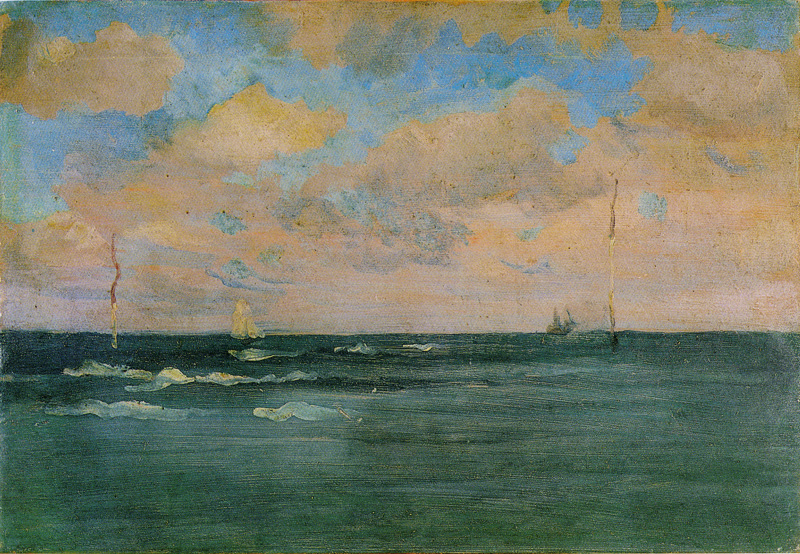
The Bathing Posts, Brittany (c.1893)

Nocturne: Chelsea (c.1881),

Nocturne: Chelsea Embankment (1883/4) and
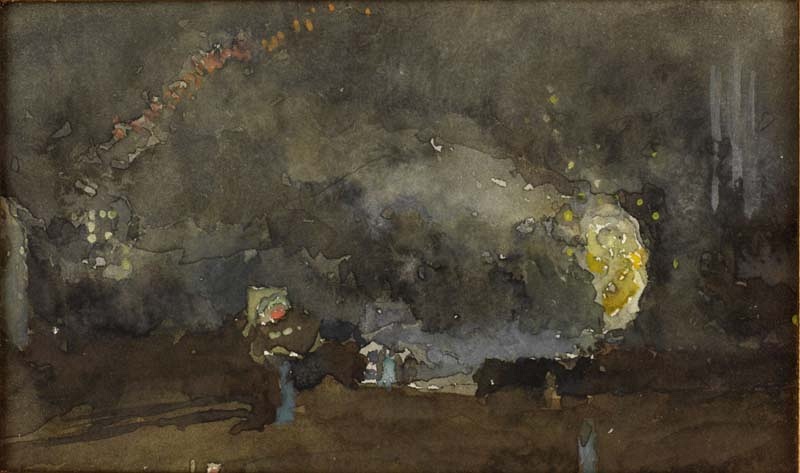
Copy of 'Nocturne: Black and Gold ‐ The Fire Wheel' (1893),
all from The Hunterian.
Whistlers’ singular vision was always defined by his enduring kinship with the makers of railroads, bridges and ships, the cornerstones of Victorian wealth and trade.
Whistler inherited a tradition of British landscape painting forged at a time when land was the predominant source of wealth. Whistler’s smoky images of warehouses, bridges, harbours and ships were themselves components of a new kind of productive, wealth‐generating landscape.
By the 1880s and 90s, Whistler’s images of parks, gardens, promenades and seaside resorts offer glimpses of the products of this wealth, in the form of suburban life and leisure, expressed in works such as
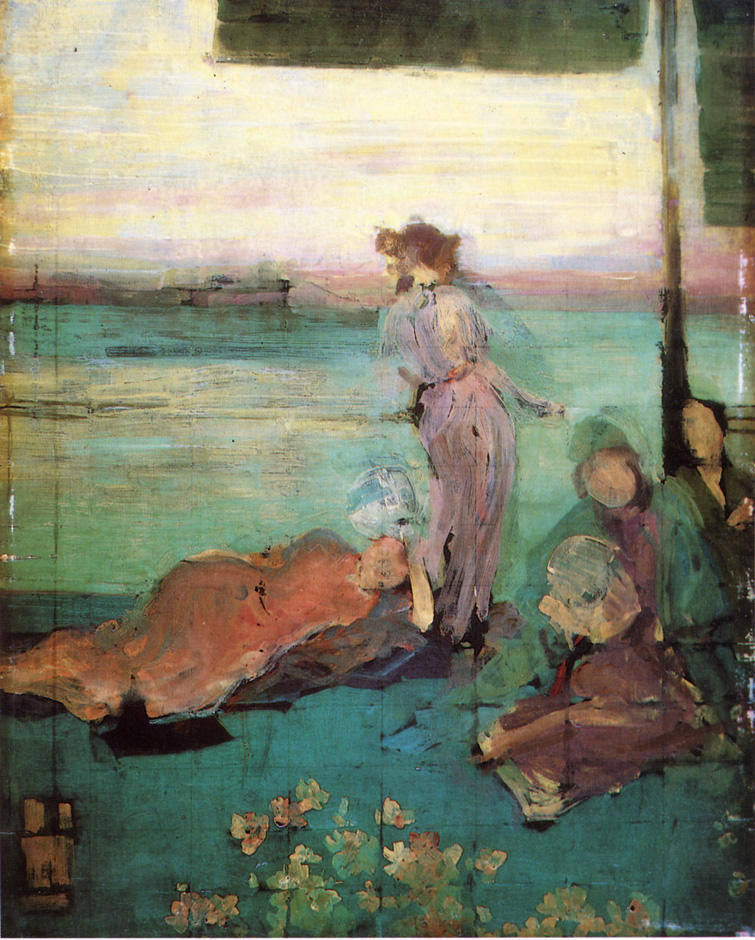
Sketch for 'The Balcony' (1867/70),
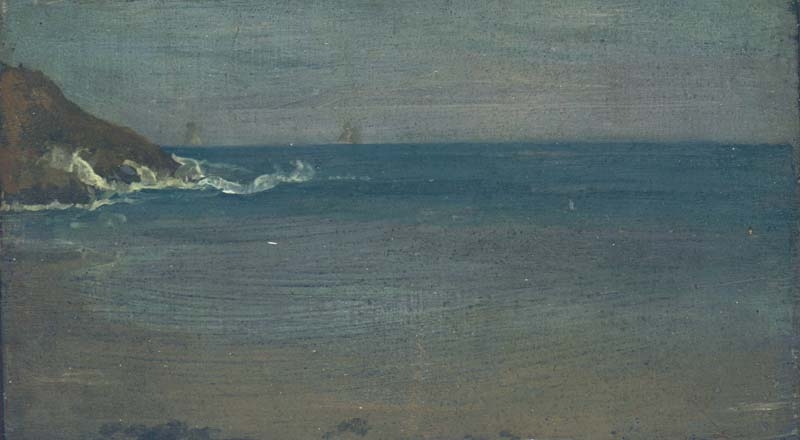
Cliffs and Breakers (1884),
The Hunterian, University of Glasgow, Birnie Philip Bequest, GLAHA 46391
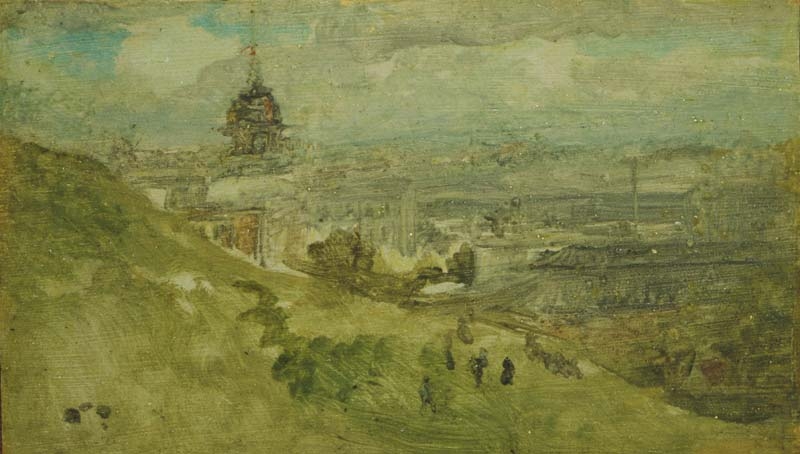
A Distant Dome (1901/04)The Hunterian, University of Glasgow, Birnie Philip Bequest, GLAHA 46392
and Sketch for ‘Annabel Lee’ (1869/70),
all from The Hunterian.
With rapid brushstrokes, Whistler captured the fleeting movement of figures – sometimes battling against the elements, at other times poised serenely in elegant robes.

The figures in Battersea Reach from Lindsey Houses (c.1864, The Hunterian), gaze out over the Thames, dwarfed by the vast, foggy expanse of the river that has been built up via layers of thin, liquefied paint, “like breath on the surface of a pane of glass,” as the artist himself put it. This is a view of nature constrained by man‐made structures – the shadowy outline of the warehouses and chimneys on the far shore, the mast and rigging of a Thames barge in the mid horizon.
Whistler and Nature showcases new research on Whistler’s technique, notably in oil, watercolour and etching, and his writings on art undertaken by academics at the University of Glasgow. It will also review Whistler’s work in the studio – his classicised figure studies in oil, pastel and chalk in the context of 19th‐century revivalism, an area that has so far received only limited research attention. Taken together, the exhibition themes shed new light on the Western classical tradition that underpins Whistler’s efforts to reinvent nature and the modern, and his reputation as the most innovative and modernizing American artist of his time.
The exhibition draws upon The Hunterian’s collection alongside other UK collections, and showcases new research on Whistler’s technique (notably in oil, watercolour and etching) and his writings on art undertaken at the University of Glasgow. It examines 19th century gradations of the productive versus the ‘wild’ landscape and review the work of Whistler – a modernising, innovative artist of his time ‐ in the context of 19th century historicism, areas that have so far received only limited research attention.

Exhibition book: Whistler & Nature by Patricia de Montfort.
The exhibition will be shown next at Newcastle upon Tyne’s Laing Art Gallery, before arriving in Glasgow in the spring of 2020.